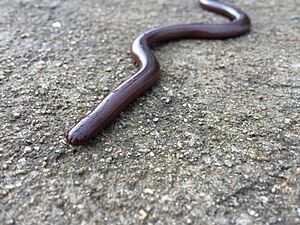Diard's blind snake facts for kids
Diard's blind snake, also known as the Indochinese blind snake, is a fascinating reptile. It's a harmless snake that belongs to the Typhlopidae family. These snakes are found in parts of South Asia and Southeast Asia. They are sometimes called "worm snakes" because of their appearance.
Quick facts for kids Diard's blind snake |
|
|---|---|
 |
|
| Conservation status | |
| Scientific classification | |
| Genus: |
Argyrophis
|
| Species: |
diardii
|
Contents
About Diard's Blind Snake
How Scientists Name Snakes
Scientists have a special way of naming and classifying living things. This is called taxonomy. The Diard's blind snake was first described by a scientist named Hermann Schlegel in 1839. He first called it Typhlops Diardii.
The first snake he studied came from a place called "Cochinchina," which is now southern Vietnam.
Where Does the Name Come From?
The name diardii and the common name "Diard's blind snake" honor a French naturalist. His name was Pierre-Médard Diard. Naturalists are scientists who study nature.
Different Types of Diard's Blind Snakes
Just like there can be different types of dogs, there are also different types of snakes within a species. These are called subspecies. There are two known subspecies of Diard's blind snake:
- Argyrophis diardii diardii
- Argyrophis diardii platyventris
What Does Diard's Blind Snake Look Like?
Diard's blind snake has a body that is quite thick for a blind snake. It has between 22 and 25 rows of scales around its body in the middle section. A cool fact about this snake is that its belly is noticeably flat.
Where Do They Live?
Habitat and Location
Diard's blind snakes live in many places across Asia. You can find them in countries like India, Bangladesh, Myanmar, Thailand, Laos, Cambodia, and Vietnam. They also live on the Malay Peninsula and islands like Nias Island, Sumatra, and Borneo.
These snakes love to live in natural places like forests, areas with lots of bushes, and open grasslands. They have also been found living in areas where people farm.


